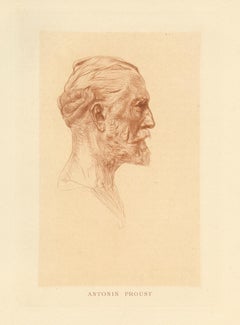Questions & Answers
Our trusted network of 1stDibs sellers answer common questions
How many pieces of art did Rodin make?
1 Answer

It has not been verified how many pieces of art Auguste Rodin made. Many of his works were copies of others, which complicates the ability to tell. Estimates of the number of his works range around 6,000. Browse an array of expertly authenticated Rodin pieces on 1stDibs.
1stDibs ExpertApril 5, 2022
Related Questions
- What is an abstract piece of art?1 Answer
- What is an original piece of art?1 Answer
- How much is a Rodin sculpture worth?1 Answer
- What is the most famous piece of art in Paris?1 Answer
- What materials did Auguste Rodin use for his sculptures?1 Answer
Shop for Auguste Rodin Art on 1stDibs
"Antonin Proust" original drypoint
By Auguste Rodin
Located in Henderson, NV
Medium: original etching and drypoint. Catalogue reference: Delteil 10. Published in Paris in 1899 by H. Floury for Auguste Rodin "Statuaire" by Lon Maillard. This impression is prin...
Category
1890s Portrait Prints
Materials
Drypoint, Etching
Small head of the Man with the broken nose
By Auguste Rodin
Located in PARIS, FR
Petite tête de l'Homme au nez cassé
Small head of the Man with the broken nose
by Auguste RODIN (1840-1917)
Sketch for the Gates of Hell
Variant with symmetric neck
Bronze with blac...
Category
Early 20th Century French School Figurative Sculptures
Materials
Bronze
Dante & Virgilus - Etching, (Ed. Goupil, 1897)
By Auguste Rodin
Located in Paris, FR
ARTISTE: after Auguste RODIN
TITLE : Dante & Virgilus
MEDIUM : Etching/photogravure after the original drawing
SIGNATURE : Unsigned
YEAR : 1897
PAPER : Vellum
SIZE : 13 x 10"
INFOR...
Category
1890s Academic Figurative Prints
Materials
Etching
Rare Rodin Watercolour & Pencil on Paper of a Seated Nude - The Cambodian Dancer
By Auguste Rodin
Located in London, GB
Auguste RODIN (1840-1917)
Seated Nude, Cambodian Dancer
c. 1898 - 1900
Pencil and watercolour
11.5 x 9.3 inches;
25 x 20.5 inches, inc. frame
Provenance:
Christie's South Kensington: Wednesday, November 28, 2007
"It's very simple. My drawings are the key of my art."
Rodin was an extraordinary creative artist and a prolific worker. After attending the “Petite École”, he worked in the studio of the ornamentalist Albert-Ernest Carrier-Belleuse, first in Paris, then in Brussels, where his skill in handling decorative subjects fashionable in the 18th century became apparent. His discovery of Michelangelo, during a visit to Italy in 1875-76, was a decisive moment in his career. Rodin would, in turn, break new ground in sculpture, paving the way for 20th-century art, by introducing methods and techniques that were central to his own artistic aesthetics.
In 1906, King Sisowath of Cambodia visited France on an official state visit. It was on this visit that Rodin discovered the dancers of the Cambodian Royal Ballet and was inspired to draw and paint them over 150 times.
They made a deep impression on the artist, as he confided to Georges Bourdon, in an article for the newspaper Le Figaro on 1 August 1906: “There is an extraordinary beauty, a perfect beauty, about these slow, monotonous dances, which follow the pulsating rhythm of the music… [The Cambodians] have taught me movements I had never come across anywhere before…”
Originally seeing them in Paris he left everything suddenly to follow the dancers of the royal ballet to Marseille, from where they would embark on their return to Cambodia.
In just one week, he made about one hundred and fifty drawings, re-transcribing or interpreting the ballet poses, with an obvious fascination for the arms and hands of the dancers. These drawings were later highlighted with watercolour, creating coloured harmonies of a rare refinement.
The first performance of the Cambodian Royal Ballet took place in the context of the Colonial Exhibition in Marseille. Sisowath 1st had just been crowned King of Cambodia when he undertook the first trip ever to be made by a Cambodian sovereign to France, which had controlled Cambodia since June 1884. This official visit occurred at the height of French colonial expansion. Previously, the Universal Exhibition of 1900 had attracted 48 million visitors! The organisers realised what a tremendous impact this event made on the public, and it was soon adopted as the main tool for colonial propaganda. At the exhibition in Marseilles, the area devoted to Indochina was the largest of the seven sections.
When Auguste Rodin met the troupe of dancers for the first time in July 1906, during their brief visit to Paris for an exceptional performance at the Pré Catalan...
Category
19th Century Realist Figurative Drawings and Watercolors
Materials
Watercolor
Iris little study, Auguste Rodin, Bronze, Sculpture, Modern Art, 1970's, Nudes
By Auguste Rodin
Located in Geneva, CH
Iris little study, Auguste Rodin, Bronze, Sculpture, Modern Art, 1970's, Nudes
Petite etude pour Iris, douzième épreuve
Ed. 12/12 pcs
1973
Bronze with brown and black patina
Marked...
Category
1970s Modern Figurative Sculptures
Materials
Bronze
Auguste Rodin "Main Droite Feminine" Bronze Sculpture by Alexis Rudier Foundry
By Auguste Rodin
Located in San Francisco, CA
Auguste Rodin French, 1840-1917
"Main Droite Feminine, doigts semi replies, annulaire leve"
Feminine Right Hand, semi-folded fingers, raised ring finger
Conceived circa 1890-1900; cast circa 1930-1940
Signed "A Rodin" on the right side of the wrist and with the foundry mark "Alexis Rudier...
Category
Early 20th Century Academic Figurative Sculptures
Materials
Bronze
